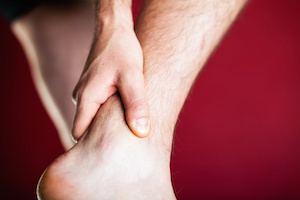Aches and pains are often part of getting older. Arthritis sets in, the joint stiffen, we become a less flexible and even walking can become difficult. It’s often put down to ‘old age’ but is there something more sinister that may be leading to the leg pain and difficulty walking? There may well be. Particularly if you are someone who has, or has been told they have, ‘poor circulation’. Ultimately, a large percentage of over 50’s who experience difficulty walking or pain in their feet will do so because of things such as arthritis, bad joints, muscle strains, pinched nerves and so on but there remains a subset of the population who experience leg pain due to what is known as peripheral arterial disease.

Peripheral Arterial Disease
Peripheral arterial disease is the medical term for narrowing or blockages in the arteries, commonly affecting the arteries that supply blood to the leg. The blockages in the arteries can happen for a number of reasons, with the main risk factors leading to artery disease being smoking, high blood pressure, high cholesterol, diabetes, kidney failure, family history of artery problems, age (older than 50), sedentary lifestyle and being overweight. People who have previously had strokes or heart attacks also have a higher chance of having artery blockages in their legs. Up to 50% of people who have blocked or narrow arteries can have little to no symptoms in their everyday life, with the problem only being unmasked when the situation becomes serious or critical.
What blocks the arteries?
The blockages are caused by ‘plaque’ – a term used to describe hardening of the arteries and build-up of fatty, cholesterol-rich material. The process usually takes many years to occur but sometimes the plaque, if disrupted, can cause a sudden and dramatic blockage of the artery.
What are the symptoms?
In reference to the legs, the symptoms can range from mild cramping or aching in the muscle when you exercise all the way to severe foot pain when you sleep at night. The leg pain caused by lack of circulation is known as claudication – a derivate of the latin term ‘claudico’ which means to limp. It often, but not always, affects the calves and thigh muscles the most but can also involve the buttock muscles. The pain starts only on exercises and is usually relieved by rest. It happens on a consistent basis every time you walk at roughly the same distance, can be reproduced and is often worse uphill.
What can you do?
If you suspect you might have blocked arteries affecting your walking or causing leg pain, it is advisable to see you GP who may refer you to a vascular surgeon or circulation specialist. A simple test checking the blood pressure at your ankles and a physical examination is often all that’s needed to confirm the diagnosis. Your specialist will then advise you about your options, whether that is medication and exercise, surgery or angioplasty. Regardless of what management pathway is chosen, a well-balanced diet, plenty of exercises and a good healthy lifestyle will play a key part in how you manage your condition moving forward. More information about conditions and risk factors affecting the circulation can be found here.
By Venu Bhamidi.
Venu Bhamidi is a Vascular and Endovascular surgeon based in Auckland. He has a very busy public practice at Auckland City Hospital and consults privately at Gilgit Road Specialist Centre. His practice encompasses all aspects of vascular disease and he is passionate about Diabetic arterial disease and wounds.
He is the clinical leader for the ADHB Multi-Disciplinary Diabetic Foot Service and strives to increase the awareness of vascular and circulation problems in the wider community.









Join the Discussion
Type out your comment here:
You must be logged in to post a comment.